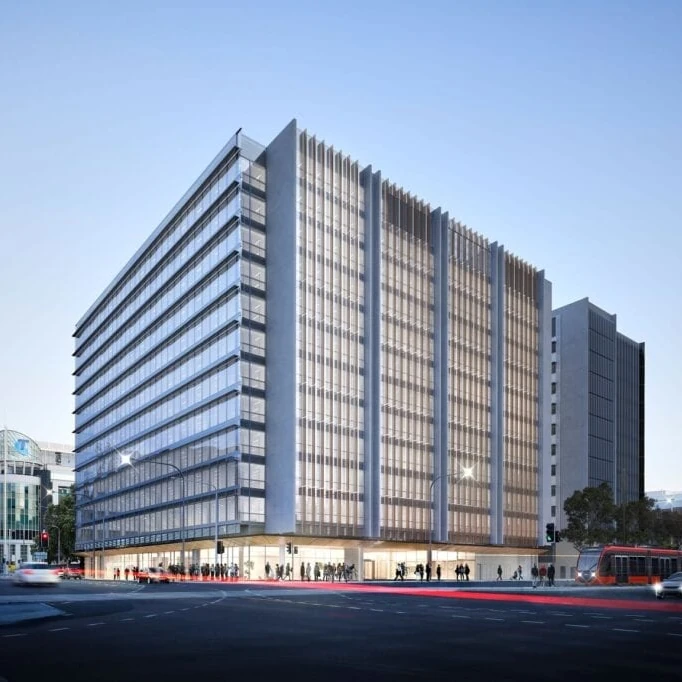Delta Q engaged Buildings Evolved to assist in a design review of Amalgamated Property Group’s Civic Quarter development in the centre of Canberra amid large operational costs associated with the prop-tech as designed and installed. It was found that the networking solution was a possibly over-engineered for the functional requirements of the tenants and operators of the building and that an off-site BMS type solution such as the CSIRO DCH could deliver considerable operational savings and access to more applications and services.

Location: Australia
Industry: Commercial Property
Project Funding: $104m
Location: Canberra City
Gross Floor Area: 39,870m²
Project Website: Civic Quarter Canberra
- 4 star green star design rating
- As built v 1.2 measurement.
- Silver Well and Core & Shell rating
- 5 star NABERs energy rating
Key Findings
Impact On Development
Question: How can a hybrid-cloud (CSIRO DCH model) provide value to a smart building development compared with business-as-usual?
| Traditional | Recommended New Approach |
|---|---|
| ◉ Client relies on building services consultant to develop requirements ◉ Building services consultant draws upon prior project work, provides a generic requirements document ◉ Contractor has to interpret generic requirements into project specific requirements, ends up building what has always been built | ◉ Applications and services should drive the functional requirements document ◉ Minimum data requirements are established and understood by the client at project inception ◉ Consultant draws upon minimum data requirement to support application driven outcomes ◉ Building infrastructure is engineered to deliver operational outcomes |
| Outcome: | Outcome: |
| Over-engineering costs the client, but reduces risk for the contractor and consultant | Over-engineering is mitigated as clear requirements are established at the outset, mitigating risk for the contractor and consultant |
Impact On Operations
Question: What is the benefit of moving from an on-premise BMS to a CSIRO DCH model?
| On premise BMS challenges | CSIRO DCH opportunities & benefits | |
|---|---|---|
| Freedom and Adapting to change | ◉ Locked-in vendors and consultants | ◉ No vendor lock-in ◉ More adaptable to change ◉ Open-source and hence able to deploy new apps when they are developed and made available |
| Storage & Infrastructure Requirements | ◉ More infrastructure required | ◉ Streamlined network architecture - Less infrastructure required ◉ Removal of long-term data storage - reduced on-site storage and elements of a datacentre ◉ Reduce the BSN scope, or integrate services onto an ICN ◉ Downsizing of bespoke CCMS/BMS |
| Integration | ◉ Providing a webpage with hyperlinks to each building service ◉ No easy “portfolio view” for multiple buildings | ◉ Integration using a common messaging protocol (e.g. MQTT) ◉ Data stored centrally on the cloud permitting a portfolio view of multiple buildings ◉ Provide unified building operations dashboard |
| Cost | ◉ More expensive | ◉ Less expensive |
Technical Summary
- BMS require large amounts of on-premise compute and storage
- BMS and EMS are often the same thing, resulting in needless duplication
- Much of the data and compute could be offloaded to a cloud-based solution such as the CSIRO Data Clearing House
- Applications and service delivery is vastly enriched via a unified data platform, negating the need for bespoke application development
- While the inclusion of an Integrated Communications Network is visionary, it is possibly over-engineered for the functional requirements of the building owners, operators and tenants
Scope
To engage in a comparative review of on-premise vs DCH cloud infrastructure solutions for Amalgamated Property Group’s Civic Quarter in Canberra City.
Civic Quarter is a “smart-ready building” - includes the infrastructure and technology requirements for a smart building.
Owners and Facility Managers want to better understand the benefit (or otherwise) of their investment in prop-tech including the Integrated Communications Network and IT systems.
Ongoing operational maintenance costs are increasing year-on-year and based on portfolio analysis are higher than that of non “smart-ready buildings”.
It has therefore been identified that with current cost increases the building operations are increasingly unsustainable in their current format - so what can be done to ensure that FMs tenants and the building owner can maximally benefit from their investment?
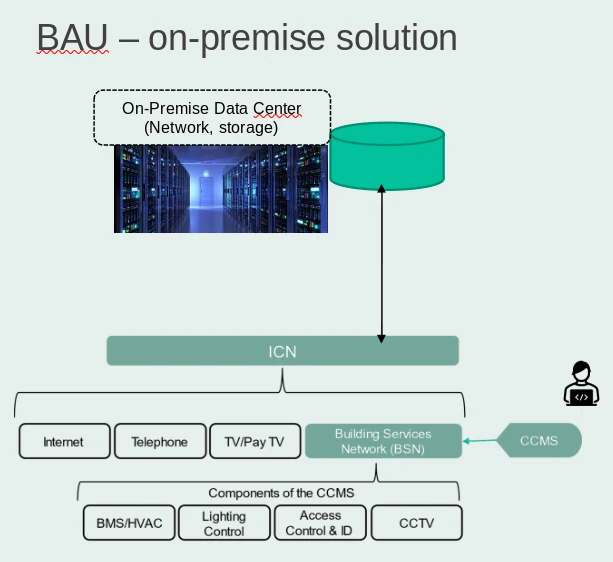 Basic data layout of the existing data systems for Civic Quarter.
Basic data layout of the existing data systems for Civic Quarter.
CSIRO Data Clearing House
Owners and operators in the built environment face significant challenges and limitations for equitable access to information. Such as:
- Struggling to consolidate data from multiple disconnected systems and service providers;
- Data vendor lock-in, vertically integrated solutions, inflexible proprietary hardware and software solutions with high fees;
- Acquiring a property often means technology uplift and retrofit to suit organisational need; and
- Limited access to skilled staff and systems to drive actionable processes in a timely manner.
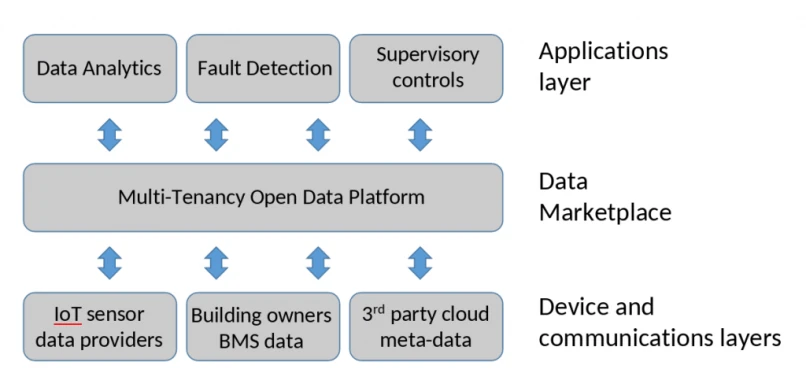
The CSIRO Data Clearing House, a pre-release solution designed to solve the above dilemmas, is being market-tested for application to a building such as APG’s Civic Quarter by comparing it to the as-built traditional on-premise BMS solution.
The CSIRO DCH introduces the concept of a non-for-profit owned regulated utility such as a stock market for supervisory control of buildings. Local loop logic at a PLC level maintains equipment in a fall-over/fail-safe mode reducing reliance on network uptime to maintain plant and equipment. PLCs communicate with the supervisory cloud directly or via a light-weight node.js based gateway to acquire optimisations for pre-heat/cool, adaptive thermal comfort based set-points, building-to-grid optimisations and predictive maintenance applications and prop-tech services.
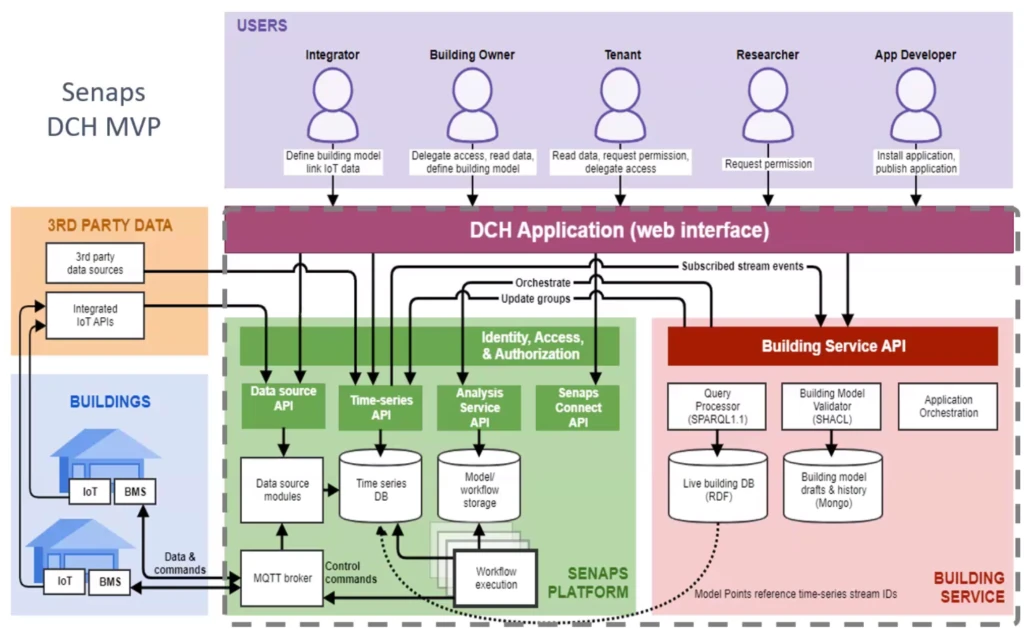 DCH software architecture diagram.
DCH software architecture diagram.
Bandwidth Requirements
The local supervisory control system, operating on BACnet IP, is incapable of transmitting data on the internet due to high bandwidth requirements, a lack of encryption, and using a non-TCP/IP transport protocol (BACnet is the same level as TCP/IP). All of these factors make it incapable of being used across the internet.
A new paradigm is emerging, using Message Queuing Telemetry Transport (MQTT) or Advanced Messaging Queuing Protocol (AMQP) - both a publish/subscribe messaging system. A “pub/sub” system is an ideal method to send and receive control messages. A message payload contains a JSON object, and could include Control Descriptor Language (CDL) objects for scheduling.
On this basis, through our analysis in BE living lab, and comparing that to the functional requirements of the building, we looked at actual and projected bandwidth requirements of the BSN connected components.
| Service | On-prem MB/s | DCH Method MB/s | % saturation of 1GBE |
|---|---|---|---|
| BMS & EMS | 100 | 10 | 1-10% |
| Lighting Controls | 50 | 50 | 5% |
| Access control & ID | 10 | 10 | 1% |
| CCTV | 100 | 100 | 10% |
| Vertical Transportation | 10 | 10 | 1% |
| 270 MB/s | 180 MB/s | 18-27% |
High Availability Network - for a Building?
From a network capacity perspective our analysis of the data processing needs for each building ‘service’ that is running: Lighting, BMS traffic, HVAC, Security system indicates that design is possibly over specified.
From a resiliency perspective this design is classified as a Availability Level 3+ which is commonly used for business requirements where large financial costs and or negative outcomes would be incurred if any or combination of digital services were not available, every minute. An understanding of service levels agreement for each service being provided by the design, should drive key parts of the overall design.
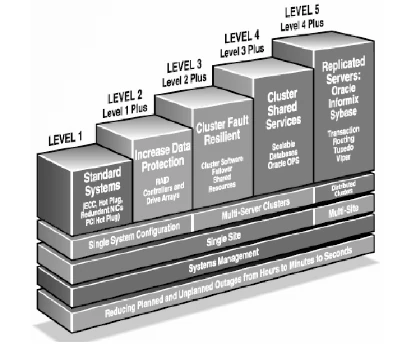 Availability level diagram. Source: Dubravko Miljković
Availability level diagram. Source: Dubravko Miljković
From a digital life cycle perspective, a highly available system design allows for systems to be patched and upgraded without compromising service availability, as you can promote or demote parts of the system without impacting the service. But is a HA design really necessary for a 11 story commercial building?
We posit that a through life cycle maintenance schedule might realise a comparative service up time, by taking advantage of time slots throughout the year, where tenants are not utilising the building and or there are backup business processes available that can be used whilst maintenance is taking place.
How often do business take advantage of the additional platform capability and evidence their HA design is working correctly? Taken to the extreme, the chaos engineering discipline in enterprise computing intentionally breaks parts of the HA system to building in iterative improvements to the HA design. Businesses have different availability needs. Those that need to remain operational around the clock throughout the year will aim for “five nines,” 99.999% of uptime. It may seem like 0.1% does not make that much of a difference. However, when you convert this to hours and minutes, the numbers are significant.
Refer to the table of nines to see the maximum downtime per year every grade involves:
| Availability Level | Maximum Downtime per Year | Downtime per Day |
|---|---|---|
| One Nine: 90% | 36.5 days | 2.4 hours |
| Two Nines: 99% | 3.65 days | 14 minutes |
| Three Nines: 99.9% | 8.76 hours | 86 seconds |
| Four Nines: 99.99% | 52.6 minutes | 8.6 seconds |
| Five Nines: 99.999% | 5.25 minutes | 0.86 seconds |
| Six Nines: 99.9999% | 31.5 seconds | 8.6 milliseconds |
As the table shows, the difference between 99% and 99.9% is substantial. The following diagram outlines the key concepts of Disaster Recovery, High availability and Fault tolerance, with respect to solutions design of digital systems.
To move from One Nine to Six Nines is a significant cost increase - both in terms of capital expenditure but also operational expenditure as 10% of the capital budget should be allocated to maintenance per annum.
Forecast optimisation, failover redundancy
Older BMS systems relied on central compute, with no logic stored on what are “remote I/O”, or what are sometimes generically referred to (and sometime incorrectly) “direct digital control” (DDC).
Making BMS controls local and redundant has been a design philosophy that has come with Sedona Framework and vendors such as Tridium and EasyIO. Other BMS manufacturers have adopted the supervisory control model, and ‘dumb’ remote I/O based systems are not the best path today.
The next phase is to lift the compute, storage and data into a common infrastructure, cutting down costs and opening up opportunities for applications and services to be developed for the industry as a whole rather than un-sustainably doing so on a building-by-building basis. Forecasts for optimised control can reliably be made to 7 days, and with some degree of certainty up to 30 days. Updates to these control schedules do not have to be immediate unless participating in real-time building-to-grid optimisation. Revenue streams from B2G services may make the business case for more “Nines” sustainable, the same as providing more value via connected applications and services increases sustainability.
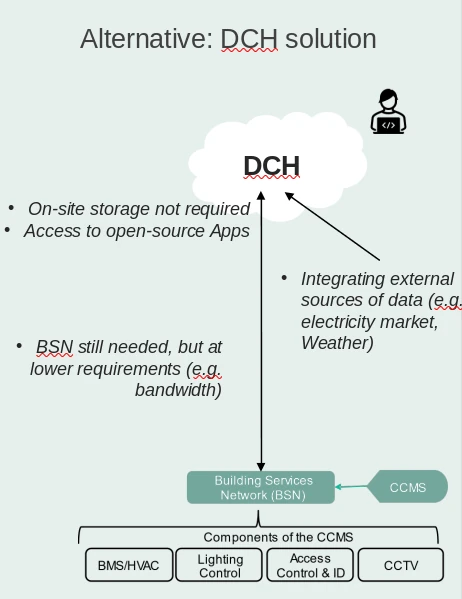 Hybrid-cloud model for building systems using the DCH concept.
Hybrid-cloud model for building systems using the DCH concept.
Conclusion
The new paradigm of a hybrid-connected cloud supervisory control system brings considerable benefits to the developer, operator and tenants of a “smart-ready building” - and in doing so turns the “smart-ready building” into a “smart and connected building”:
- Applications and services can be provided to tenants and visitors using a common Application Programming Interface (API) - consistent across multiple buildings.
- Group reporting is made simpler by unifying all IoT/building data into a common repository, again accessible via common API.
- On-premise IT and data-centre equipment can be dramatically reduced while improving system uptime through decentralisation of control logic or taking advantage of decentralised logic.
- Capital and operational costs of developing a truly smart and connected building with B2G/demand flex capability are less than that of a on-premise “smart-ready building”.

